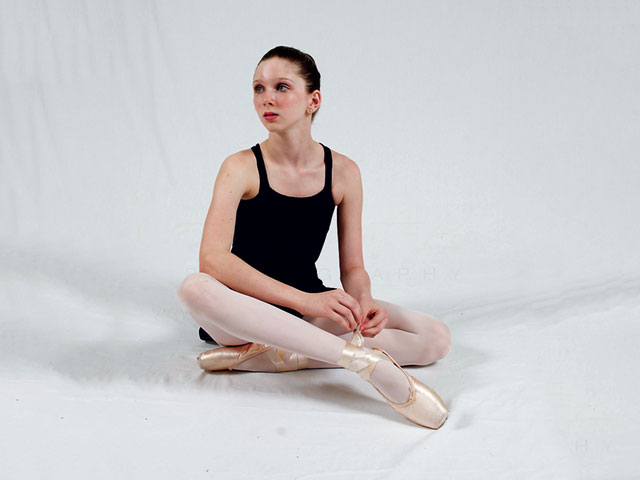For as long as I have been teaching ballet I have always had students and parents ask me when they/their child will be ready for pointe shoes. There is no magic age at which children are put on pointe. It is a lot more complicated than that. For me, it is a complex formula of many things. Age, bone and muscle development, size and stature of parents, amount of time doing ballet technique and most crucially, the student’s commitment to their art form, are all things I take into consideration when putting a student up on pointe.
Let’s take a moment and discuss some of these. Age, bone and muscle development, along with size and stature of parent, all fit together. The rough age I might even consider putting a student up on pointe is 11 or 12. A child around that age with three-to-five years of a strong ballet foundation, in my experience, usually has the required bone and muscle development needed to begin pointe. A child of 11 or 12 who has been doing ballet for that long has developed the strong feet and ankles needed to start pointe. Many studios rush into putting their students on pointe, but going on pointe too early can cause serious damage to a child’s feet and toes. If a student has not had a strong foundation of ballet technique then they will probably have weak ankles and going up on pointe could lead to ankle sprains, tendonitis and other painful foot and toe issues. If your ballet teacher has not approached you about putting your child up on pointe, please, please, please do not do it yourself. Choosing the correct pointe shoe is another crucial element in maintaining the health of your child’s feet. We will dive into that in a moment.
When putting a student on pointe it is vital that they be committed to their art form. Not only should they have the proper ballet foundation for a smooth transition to pointe work, but once those pointe shoes have finally been attained, it is also important that they continue, diligently, to maintain the strength needed to be on pointe. At my studio, students must dance at least four hours of ballet a week to continue on pointe. Jazz, lyrical, modern, tap and hip hop are great forms of dance but they do not provide the proper amount of foot strength to maintain the level of strength needed to improve in pointe work. Pointe is hard. Pointe is painful. But the reason why we all do it, and why everyone wants to go up on pointe, is because it is beautiful! Those shiny pink satin pointe shoes and those beautiful laces and the way a dancer just glides across the floor are the images in all of my students’ heads before they go up on pointe. It takes years to master some of the simplest steps on pointe; therefore, it is extremely important to continue regular technique classes along with pointe classes.
Getting fitted correctly for pointe shoes is a critical first step in going up on pointe. For as long as I have been teaching (roughly 25 years), I have gone to the store with every single student for their first pointe shoe fitting. I know my students’ feet better than anyone else on the planet! Even more than their own parents! I know how strong their feet are, how high their arch is, how their right foot is stronger than their left, how the second toe is longer than the first, and much more. I also know all of the pointe shoe options on the market and how they will or won’t work for each of my students’ feet. There is a huge selection of pointe shoes and sometimes finding the right one is difficult. It is important to not get frustrated. There is a shoe out there for everyone! If a shoe is too tight it might cause tendonitis or painful blisters on their heels. If a shoe is too loose the foot can move around too much, causing ankle strains and blisters on their toes because of the friction. Pointe is already painful enough just getting up to the tips of the toes, so having a proper fitting shoe will lessen the pain and help support the arch, toes and ankles for a healthy dancer.










 Deering Estate
Deering Estate
 Massage Envy South Miami
Massage Envy South Miami
 Calla Blow Dry
Calla Blow Dry
 My Derma Clinic
My Derma Clinic
 Sushi Maki
Sushi Maki
 Sports Grill
Sports Grill
 The Healthy Kitchen
The Healthy Kitchen
 Golden Rule Seafood
Golden Rule Seafood
 Malanga Cuban Café
Malanga Cuban Café

 Kathleen Ballard
Kathleen Ballard
 Panter, Panter & Sampedro
Panter, Panter & Sampedro
 Vintage Liquors
Vintage Liquors
 The Dog from Ipanema
The Dog from Ipanema
 Rubinstein Family Chiropractic
Rubinstein Family Chiropractic
 Your Pet’s Best
Your Pet’s Best
 Indigo Republic
Indigo Republic




 ATR Luxury Homes
ATR Luxury Homes


 2112 Design Studio
2112 Design Studio
 Hamilton Fox & Company
Hamilton Fox & Company
 Creative Design Services
Creative Design Services
 Best Pest Professionals
Best Pest Professionals
 HD Tree Services
HD Tree Services
 Trinity Air Conditioning Company
Trinity Air Conditioning Company
 Cisca Construction & Development
Cisca Construction & Development
 Mosquito Joe
Mosquito Joe
 Cutler Bay Solar Solutions
Cutler Bay Solar Solutions


 Miami Royal Ballet & Dance
Miami Royal Ballet & Dance
 Christopher Columbus
Christopher Columbus
 Pineview Preschools
Pineview Preschools
 Westminster
Westminster
 Carrollton
Carrollton
 Lil’ Jungle
Lil’ Jungle
 Frost Science Museum
Frost Science Museum
 Palmer Trinity School
Palmer Trinity School
 South Florida Music
South Florida Music
 Pinecrest Orthodontics
Pinecrest Orthodontics
 Dr. Bob Pediatric Dentist
Dr. Bob Pediatric Dentist
 d.pediatrics
d.pediatrics
 South Miami Women’s Health
South Miami Women’s Health

 The Spot Barbershop
The Spot Barbershop
 My Derma Clinic
My Derma Clinic




 Miami Dance Project
Miami Dance Project

 Rubinstein Family Chiropractic
Rubinstein Family Chiropractic
 Indigo Republic
Indigo Republic

 Safes Universe
Safes Universe
 Vintage Liquors
Vintage Liquors
 Evenings Delight
Evenings Delight





 Atchana’s Homegrown Thai
Atchana’s Homegrown Thai
 Baptist Health South Florida
Baptist Health South Florida

 Laser Eye Center of Miami
Laser Eye Center of Miami
 Visiting Angels
Visiting Angels
 OpusCare of South Florida
OpusCare of South Florida

 Your Pet’s Best
Your Pet’s Best





 HD Tree Services
HD Tree Services
 Hamilton Fox & Company
Hamilton Fox & Company


 Creative Design Services
Creative Design Services